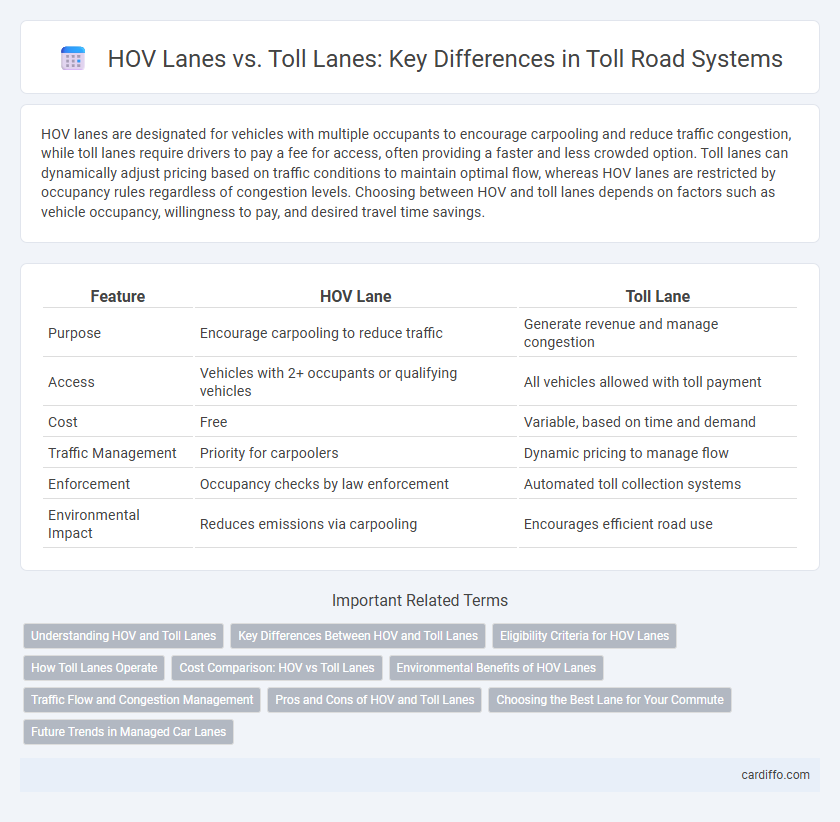HOV lanes are designated for vehicles with multiple occupants to encourage carpooling and reduce traffic congestion, while toll lanes require drivers to pay a fee for access, often providing a faster and less crowded option. Toll lanes can dynamically adjust pricing based on traffic conditions to maintain optimal flow, whereas HOV lanes are restricted by occupancy rules regardless of congestion levels. Choosing between HOV and toll lanes depends on factors such as vehicle occupancy, willingness to pay, and desired travel time savings.
Table of Comparison
| Feature | HOV Lane | Toll Lane |
|---|---|---|
| Purpose | Encourage carpooling to reduce traffic | Generate revenue and manage congestion |
| Access | Vehicles with 2+ occupants or qualifying vehicles | All vehicles allowed with toll payment |
| Cost | Free | Variable, based on time and demand |
| Traffic Management | Priority for carpoolers | Dynamic pricing to manage flow |
| Enforcement | Occupancy checks by law enforcement | Automated toll collection systems |
| Environmental Impact | Reduces emissions via carpooling | Encourages efficient road use |
Understanding HOV and Toll Lanes
High-Occupancy Vehicle (HOV) lanes are designated for vehicles with multiple passengers, promoting carpooling and reducing traffic congestion by encouraging shared rides. Toll lanes, also known as express lanes, allow solo drivers to pay a fee for faster travel during peak hours, managing demand and optimizing road capacity. Understanding the distinct rules and benefits of HOV and toll lanes helps drivers choose the best option for efficient and cost-effective commuting.
Key Differences Between HOV and Toll Lanes
HOV lanes are reserved for vehicles carrying multiple passengers, promoting carpooling and reducing traffic congestion, while toll lanes allow all vehicles to use the lane by paying a fee, providing quicker travel options. HOV lanes aim to decrease emissions and traffic by incentivizing shared rides, whereas toll lanes generate revenue and manage demand through dynamic pricing. Enforcement differs as HOV lanes require passenger verification, and toll lanes use electronic toll collection systems to monitor and charge users.
Eligibility Criteria for HOV Lanes
HOV lanes are designed to promote carpooling by requiring a minimum number of occupants, usually two or more, per vehicle for eligibility, whereas toll lanes allow solo drivers to use the lane by paying a fee. Eligibility for HOV lanes often includes motorcycles, vanpools, and certain low-emission vehicles equipped with specific decals or permits, depending on regional regulations. Tolls vary based on traffic congestion, time of day, and lane usage, contrasting with the occupancy-based restrictions strictly enforced in HOV lane access.
How Toll Lanes Operate
Toll lanes operate by charging drivers a fee based on real-time traffic conditions, using electronic toll collection systems such as transponders or license plate recognition to ensure smooth and efficient payment processing. Unlike HOV lanes reserved exclusively for vehicles with multiple occupants to promote carpooling, toll lanes allow solo drivers to access less congested routes by paying a variable toll that adjusts with traffic flow. This dynamic pricing helps manage lane demand, reduce congestion, and optimize highway capacity.
Cost Comparison: HOV vs Toll Lanes
HOV lanes are typically free for vehicles with multiple occupants, reducing commuting costs for carpoolers, while toll lanes require drivers to pay variable fees based on congestion levels, making them more expensive for solo motorists. Toll lane pricing aims to manage traffic flow and provide a faster travel option, with costs fluctuating during peak hours, whereas HOV lanes promote carpooling by offering a cost-free alternative. Choosing between HOV and toll lanes depends on individual priorities of cost savings versus travel time efficiency.
Environmental Benefits of HOV Lanes
HOV lanes significantly reduce vehicle emissions by encouraging carpooling, which lowers the total number of cars on the road and decreases traffic congestion. Studies show that HOV lanes can cut greenhouse gas emissions by up to 30% compared to toll lanes, which primarily manage traffic flow through pricing without directly reducing vehicle count. The environmental benefits of HOV lanes contribute to improved air quality and support sustainable urban transportation strategies.
Traffic Flow and Congestion Management
HOV lanes prioritize vehicles with multiple occupants to maximize traffic flow efficiency by reducing the number of cars on the road, thereby managing congestion effectively during peak hours. Toll lanes, often referred to as express lanes, dynamically adjust fees based on real-time traffic conditions to regulate demand and maintain steady speeds. Both systems aim to optimize road capacity, but toll lanes provide flexible congestion management by incentivizing drivers to pay for faster travel.
Pros and Cons of HOV and Toll Lanes
HOV lanes prioritize carpooling and reduce traffic congestion by encouraging multiple passengers per vehicle, resulting in lower emissions and improved commute times but may underutilize capacity during off-peak hours. Toll lanes generate revenue that can fund transportation infrastructure and provide a reliable travel option with dynamic pricing to manage congestion; however, they may create equity issues by favoring drivers who can afford toll fees. Balancing HOV lanes' environmental benefits with toll lanes' financial advantages is essential for optimized traffic flow and sustainable urban mobility.
Choosing the Best Lane for Your Commute
Choosing the best lane for your commute depends on your vehicle occupancy and travel priorities. HOV lanes offer free or reduced toll access for carpools, buses, and motorcycles, promoting faster travel during peak hours. Toll lanes provide a reliable option for solo drivers willing to pay for reduced congestion and predictable travel times.
Future Trends in Managed Car Lanes
Future trends in managed car lanes highlight increased integration of dynamic pricing and advanced sensor technologies to optimize traffic flow in both HOV and toll lanes. Autonomous vehicles are expected to further enhance lane efficiency by communicating with infrastructure for real-time lane management and congestion reduction. Implementation of smart infrastructure will support seamless lane transitions and equitable access, promoting sustainable urban mobility.
HOV vs Toll lane Infographic

 cardiffo.com
cardiffo.com